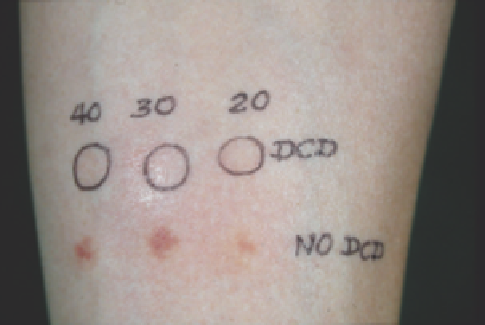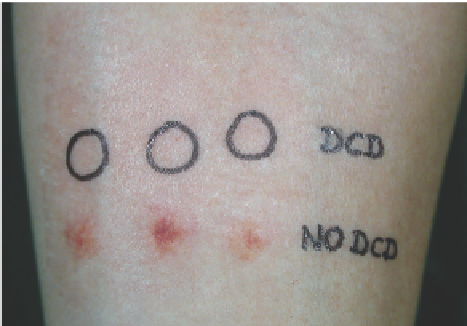Biomedical Engineering Reference
In-Depth Information
this complication resolved spontaneously without using any
topical preparations other than a broad-spectrum sunscreen
and sun avoidance.
Sun Avoidance
UV exposure prior to laser treatment has been shown to inter-
fere with laser treatment by increasing epidermal melanin pig-
mentation and epidermal thickness leading to a change in the
optical property of the skin (183). UV exposure may also
interfere with the posttreatment healing process (263,264),
altering the treatment outcome, and occurrence of side effects.
Moreover, laser exposure may infl uence the carcinogenic
potential of UV radiation, which serves as a complete carcino-
gen, as both tumor initiation and promotion are induced by
UV (265). Nonetheless, results from an experimental study
conclude that CO
2
laser treatment does not have a carcino-
genic potential in itself nor does CO
2
laser treatment infl uence
UV-induced carcinogenesis (266).
In our practice, several recommendations to minimize the
effects of UV light have been suggested. From a practical
standpoint, it is not easy to avoid sun exposure when living in
tropical countries. Most laser treatments are elective surgeries.
Thus, surgery may be postponed during summer months.
Topical sunscreens protecting against both UVA and UVB,
usually zinc oxide based, should be applied regularly at least
6 weeks prior to the treatment to obtain the optimal outcome
(188). Patients should not visit tanning booths or go sunbath-
ing, although the infl uence of acquired pigmentation com-
pared with constitutional pigmentation for the development
of adverse effects remains unidentifi ed.
Epidermal Cooling
Selective epidermal cooling during laser surgery provides great
benefi ts, allowing the use of higher fl uences, permitting treat-
ment of darker skin tones and decreasing procedure discom-
fort. For treating pathology that is situated beneath either the
epidermis or superfi cial dermis, it may often be necessary to
use higher fl uences to deliver suffi cient photons to the intended
target. This applies especially to laser surgery for Asian patients,
in whom higher epidermal levels of melanin effectively
decrease the number of photons reaching the dermis.
Because scarring is related to the generation of excessive
heat, which is greatest at or near the skin surface, methods that
cool the superfi cial compartment of the skin should permit
the safe use of higher fl uences when necessary and minimize
epidermal injury when it occurs (Fig. 13.25). When the epider-
mis and/or superfi cial dermis are selectively cooled either
immediately before or during laser exposure, the peak tem-
perature reached at these sites is insuffi cient to cause irrevers-
ible thermal damage. However, targets that are situated more
deeply and that are, therefore, not cooled are able to reach the
thermal threshold necessary for successful treatment.
Lowering the temperature of the skin's surfaces is therefore a
method for selectively controlling the depth at which heat is
produced in the skin by lasers or light sources. The effect of
epidermal cooling has been shown to enhance clinical effi cacy
and minimize epidermal damage caused by the laser treatment
process (276-280). The increased effi cacy is a consequence of
an increase in the depth of penetration (200) and an allowance
of higher energy fl uence used (281,282).
When not using a dynamic cooling device, the depth to
which skin cooling protects the skin from excessive superfi cial
heat injury is largely determined by the temperature and con-
tact time of the handpiece or cryogen with the skin. An appro-
priate cooling time and technique permit heat extraction from
the epidermis before, during, and after each laser pulse. Thus
epidermal damage/heating can be minimized. In contrast, an
Preoperative and Postoperative
Treatment Regimen
Although the advantage of preoperative treatment regimens
with various topical bleaching agents remains controversial
(169,267), in current practice we regularly pretreat our patients
with a minimal 2-week course of topical retinoic acid (268,269)
each night, combined with any of the following topical prepa-
rations, including hydroquinone (270), kojic acid (271), aze-
laic acid (272), arbutin (273), licorice (274), or vitamin C
(275). On the postoperative visit, these topical preparations
are started as soon as possible (2-4 weeks), depending on the
individual healing response. However, we often observe that
PIH occurred even with careful preoperative treatment, and
(
A
)
(
B
)
Figure 13.25
(
A
) Immediate reaction after a 595-nm pulse dye laser irradiation on a skin type IV subject at a fl uence of 10 J/cm
2
and pulse duration of 20, 30, and
40 ms, with and without epidermal cooling using DCD. The epidermis was well protected when cooled; (
B
) 24 hours after laser irradiation.
Abbreviation
: DCD,
dynamic cooling device.

















